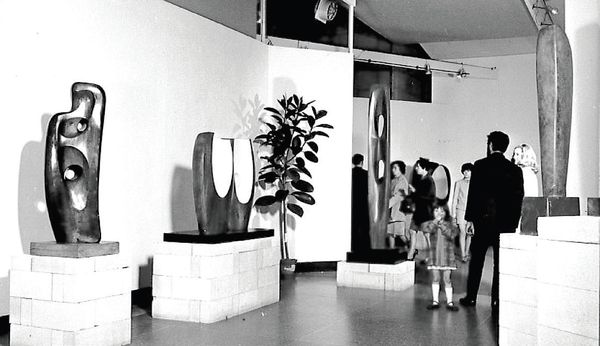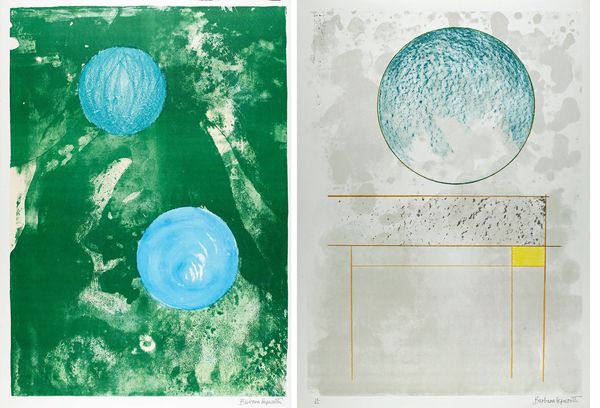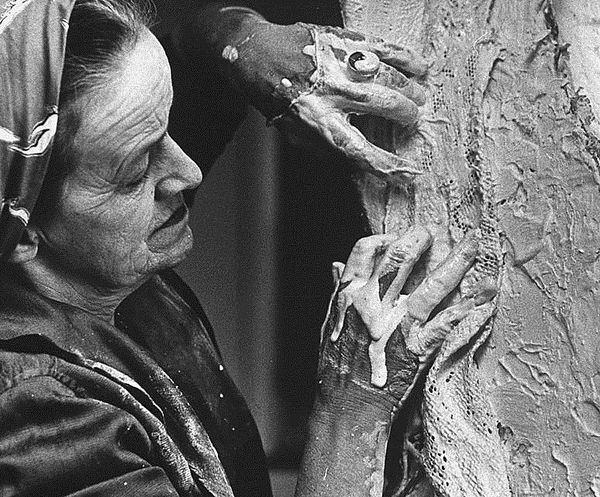Hepworth at work in the Palais de Danse studio.
By the time she reached what would be her last decade in 1965, Barbara Hepworth was firmly established as one of Britain's most prominent artists. In 1959, she became the first British artist to win the Grand Prix at the São Paulo Biennial, surpassing the successes of Henry Moore, winner of the International Sculpture Prize in 1953, and Ben Nicholson, winner of the International Painting Prize in 1957.
Such was the achievement that distinguished critic Herbert Read wrote a letter congratulatng her, commenting "The prize is the great event. You need have no more worries." Indeed, the recognition prompted several prominent public commissions — notably, Winged Figure for Oxford Street's John Lewis in 1963 and Single Form for New York's United Nations in 1964.

London, Tate Britain, Barbara Hepworth, 1968 © Tate, London 2016.
Hepworth's status as a leading British artist was consolidated with a major retrospective at the Tate Gallery in 1968. This exhibition presented recent metal works alongside the universally-lauded early carvings, demonstrating an increasing experimentation with materials. In a film documenting the Tate show, Hepworth shared words she had initially written for a British Council talk in 1961, stating, "in always remaining constant to my conviction about truth to material, I have found a greater freedom for myself." She discusses her engagement with metal in more depth, noting, "I found out the nature of its construction and forced it to express what I wanted by its nature and not against its nature."

(Left) Barbara Hepworth Sun Setting from The Aegean Suite, 1971. Lithograph on paper. The Hepworth Wakefield (Wakefield Permanent Art Collection), © Bowness; (Right) Barbara Hepworth Sun and Marble from The Aegean Suite, 1971. Lithograph on paper. The Hepworth Wakefield (Wakefield Permanent Art Collection), © Bowness
In 1969, Hepworth made her first major suite of prints, Twelve Lithographs, typifying an intuitive probing of forms from two to three dimensions and back again that had long been present in the dialogue between her drawings and sculptures. Later suites, Opposing Forms (1970) and The Aegean Suite (1971), continued this dialogue, and the exhibition at Phillips provides a rare opportunity to see all three significant bodies of work together alongside sculptures to which they relate.
In addition to an experimental approach to materials, the filmic record of her 1968 retrospective showcases Hepworth staging her works in new ways. Tate's grand neoclassical Sculpture Gallery was divided by white angular screens with the sculptures — except those standing directly on the floor, shown on plinths made of concrete blocks rather than the more traditional white-painted wood. This modification of shifts the plinth from a neutral display mechanism to something engaged by the artist's hand.

London, Tate Britain, Barbara Hepworth, 1968 © Tate, London 2016.
Throughout the exhibition are potted plants, reinforcing the sense of bringing items into a museum that are normally kept outside. For Hepworth, the association of these materials may have been one of home, recreating the way she placed sculptures in her garden studio in St Ives and thereby recalling the context of an active, creative process in contrast to an inert, museological display. The concrete blocks and plants feel strangely contemporary now, as the incorporation of the plinth into sculpture is a strategy used by many artists to both question the status of sculpture and re-frame the viewers' encounter with the work. It is fascinating to see the continuation of these concerns which occupied Hepworth some fifty years ago, during this dynamic period of her career.
— Eleanor Clayton, Curator, The Hepworth Wakefield
